Hands on: the Lenovo ThinkBook Plus Twist is a revolution for laptop designs
This is a hands-on review to give you the chance to see what the Lenovo ThinkBook Plus Twist (2023) is all about as soon as possible. Stay tuned as we'll be expanding and upgrading this hands on review very shortly with more info.
Lenovo has a lot to show off at MWC 2023, including a bevy of new laptops. While the ThinkPad X1 Fold and ‘rollable’ laptop concept might ostensibly be the stars of the show, I was actually more impressed with Lenovo’s ground-breaking redesign of the old ThinkBook Twist.
We reviewed the original Lenovo ThinkBook Twist more than a decade ago, and found it to be a high-quality - if somewhat niche - piece of hardware. At first glance, the ThinkBook Plus Twist doesn’t do much to shake up the old design. It’s immediately sleeker and more attuned to our modern laptop sensibilities; gone are the classic ThinkBook mouse buttons and Lenovo’s iconic red laptop nipple (sorry, ‘trackpoint’) in favor of a stylish grey metallic finish with a conventional trackpad.
But once you spin that rotating display around, hoo boy - there’s a whole ‘nother screen back ‘ere! It’s no conventional laptop screen, either. The rear display on the ThinkBook Plus Twist uses Lenovo’s new ‘Smart Paper’ touchscreen technology, which utilizes e-paper the same way ereaders such as the Amazon Kindle do.
Packing the latest 13th-gen Intel Core processor and two very different displays, did the Lenovo ThinkBook Plus Twist impress me as much as it did the first time around? Let’s dig into the details and find out.
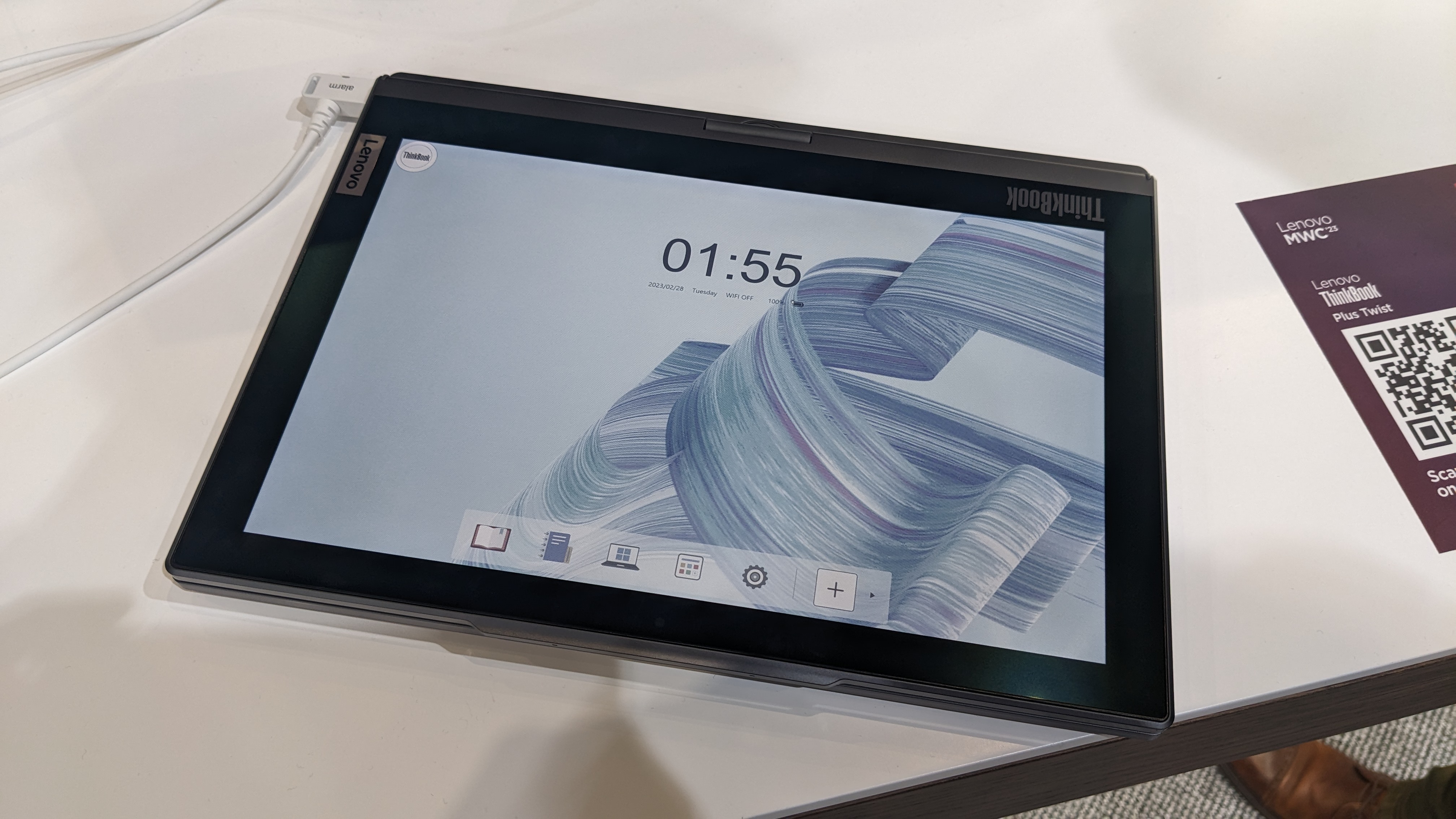
Lenovo ThinkBook Plus Twist review: Price and availability
I don’t have full pricing information on the Lenovo ThinkBook Plus Twist yet, but I do know the starting price in the US will be $1,649 (about £1,360 / AU$2450). The model I saw at MWC 2023 featured an Intel Core i7 processor, but I suspect that the $1,649 price will be for an entry-level i5 model instead.
While the ThinkBook Plus Twist doesn’t have a concrete release date just yet, it’s expected to launch in June 2023 in the US. Official pricing and launch details for other regions have yet to be revealed, but based on current laptop market projections it’ll likely cost a bit more than the above price in the UK, Europe, and Australia.
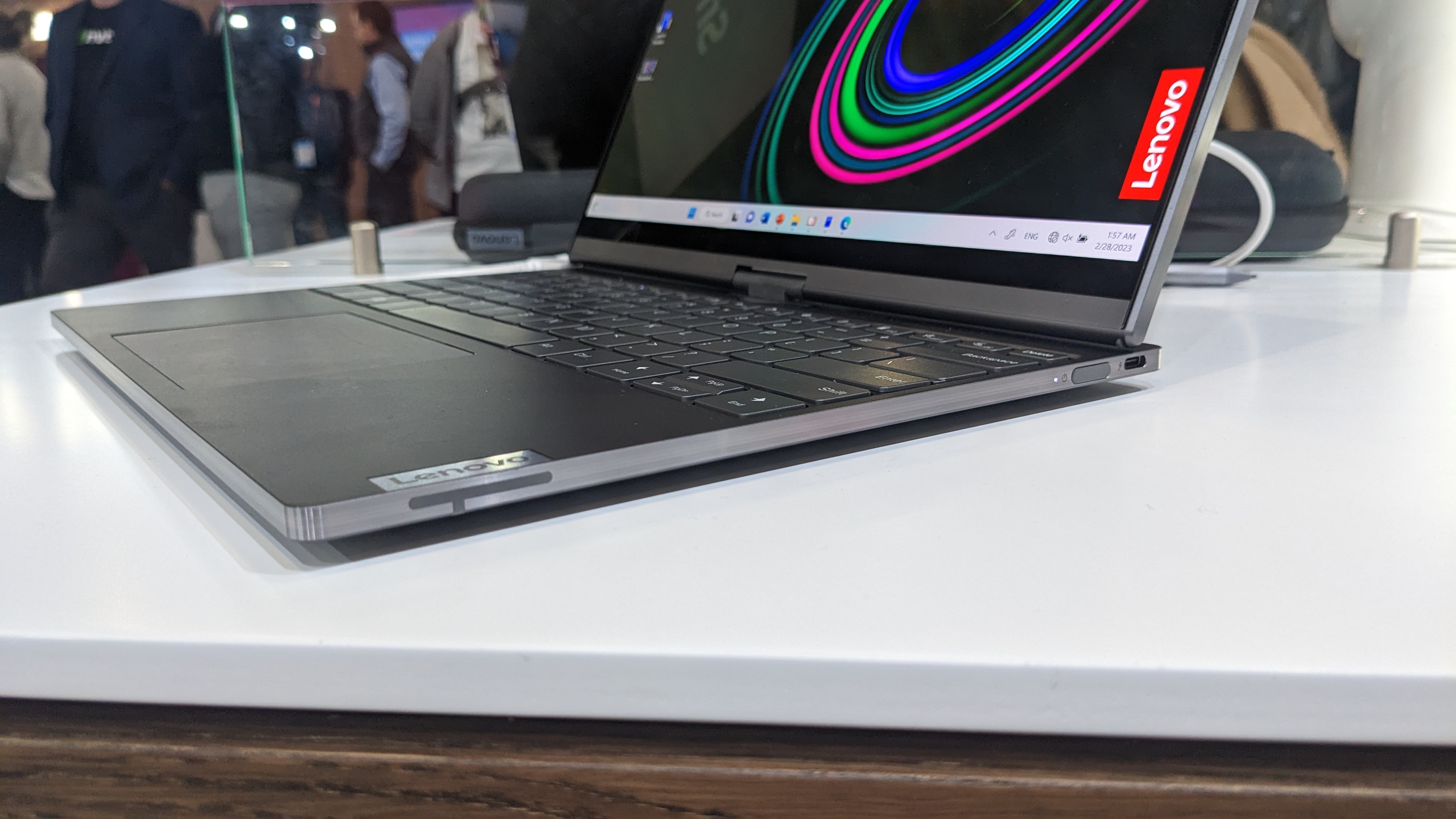
Lenovo ThinkBook Plus Twist review: Design
While the original model’s rotating central hinge was essentially just a convoluted way to swap the Twist to tablet mode (or maybe spin the screen around to show something to a coworker across the desk from you), here it’s a lot more important.
Now, it feels revolutionary (no pun intended). When the laptop is closed normally, the E Ink rear display displays a static smartphone-esque lock screen with the time and your calendar appointments. You can use it like a conventional - if bulky - e-reader in this state; open the lid and you can use it like a regular laptop, or spin it around and close the lid to swap to tablet mode.
The most intriguing configuration, though, is using it in laptop mode with the screen rotated - Lenovo calls this ‘typewriter mode’. The e-paper display is full color, unlike the average e-reader, and also backlit for use in low-light environments. It’s 12 inches diagonally, smaller than the standard display, with a chunky bezel that we wish was thinner. It actually runs Windows 11 normally; while it looks a bit weird and the choppy 12Hz refresh rate makes it feel sluggish, it’s surprisingly functional and fine for writing (or drawing, since the Lenovo Smart Paper has stylus support too).
Since the main display is a 13.3-inch 2.8K OLED panel with full touch and stylus support, it’s ideal for content creators - and just generally looks fantastic. It’s perhaps not the brightest OLED screen we’ve ever seen, but it’s bright enough and the color reproduction is solid.
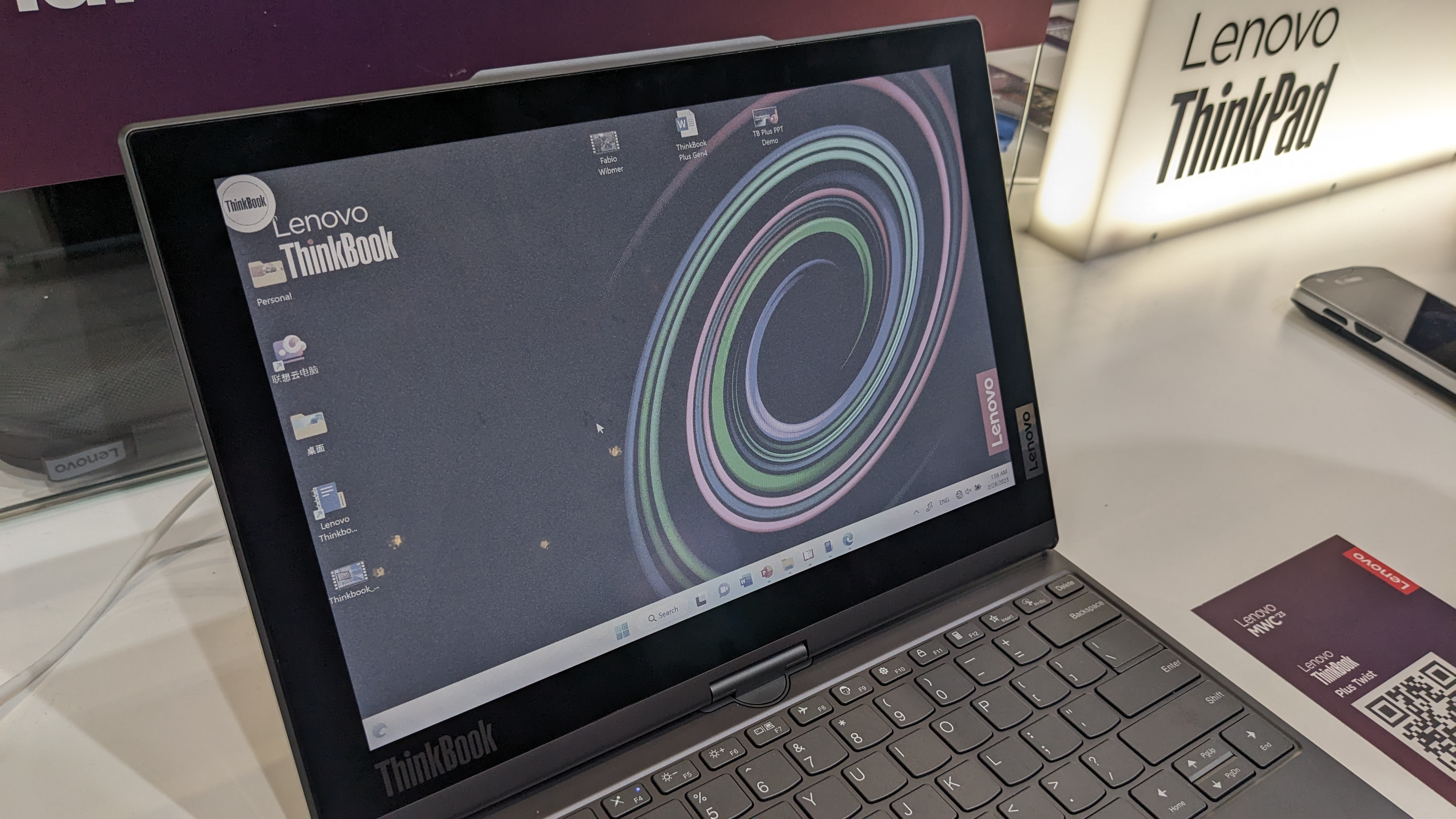
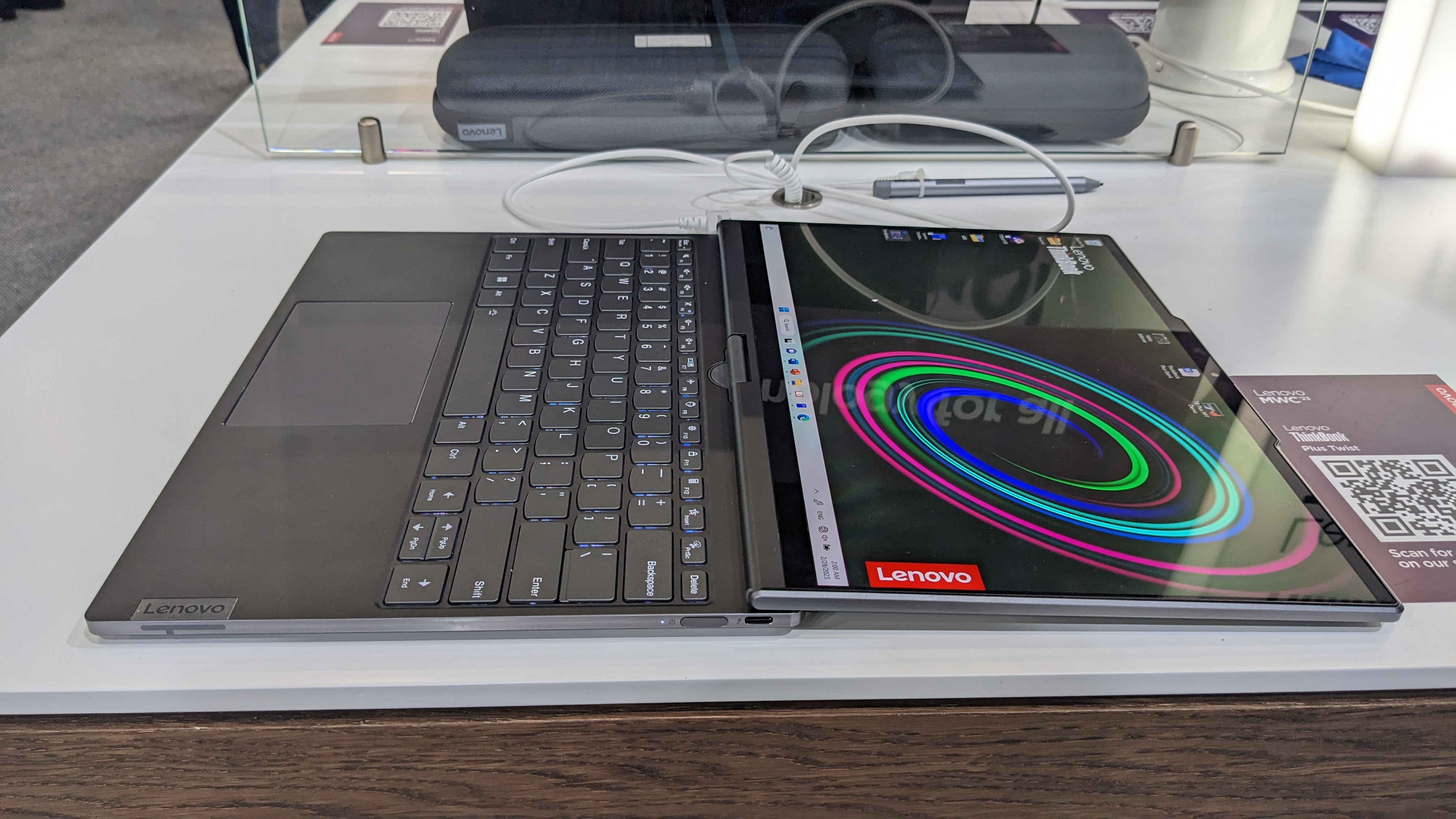
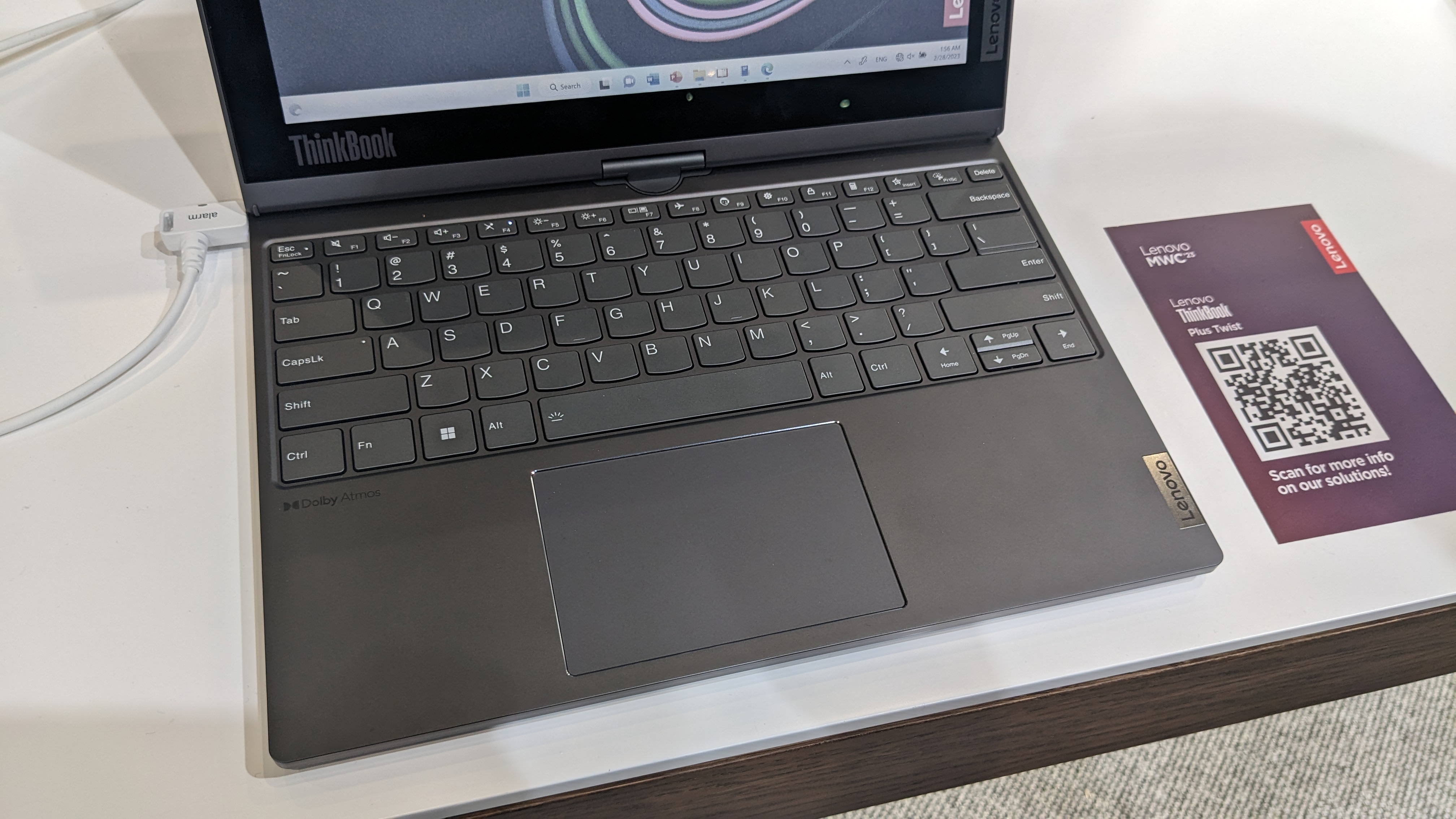
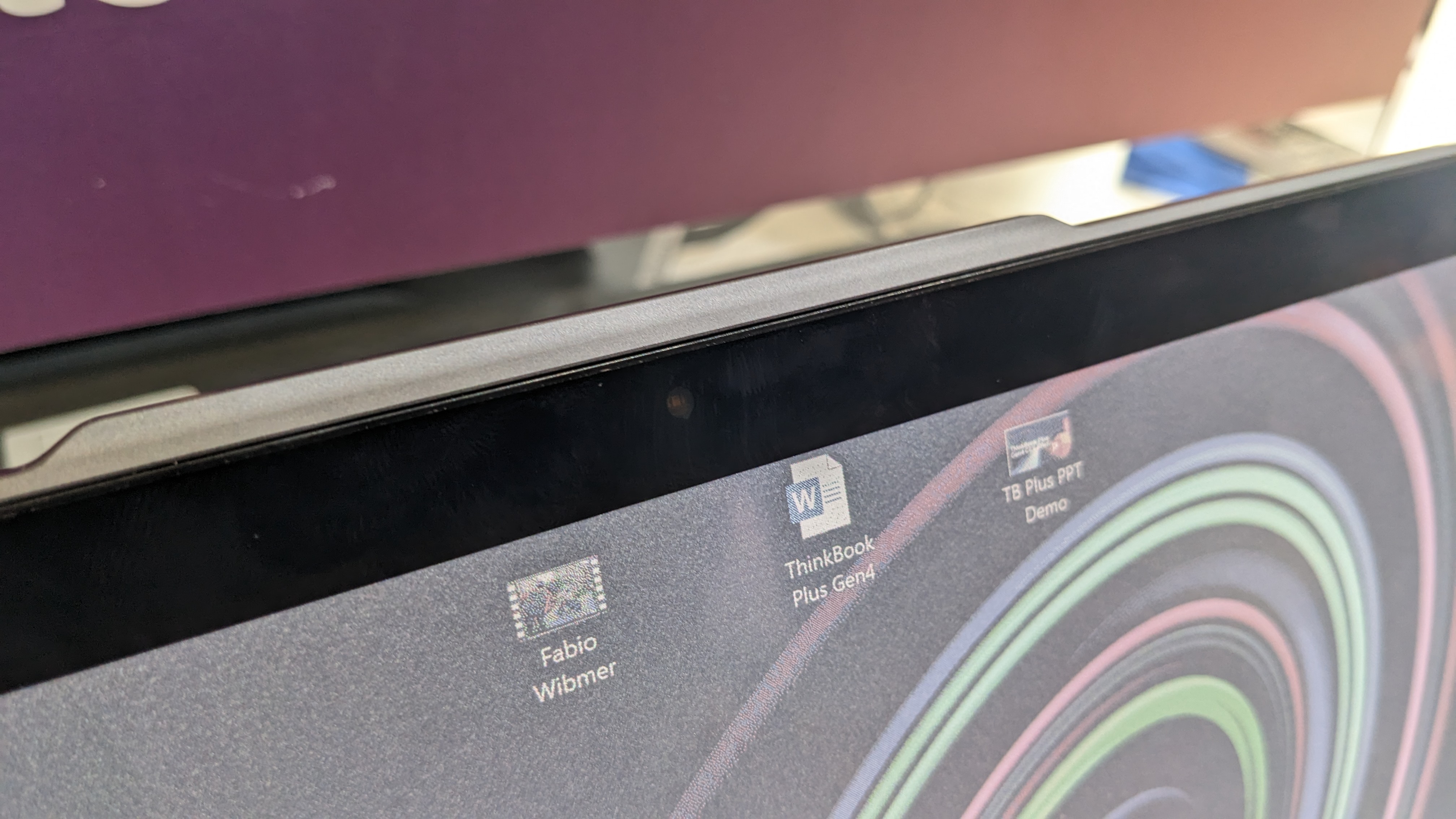
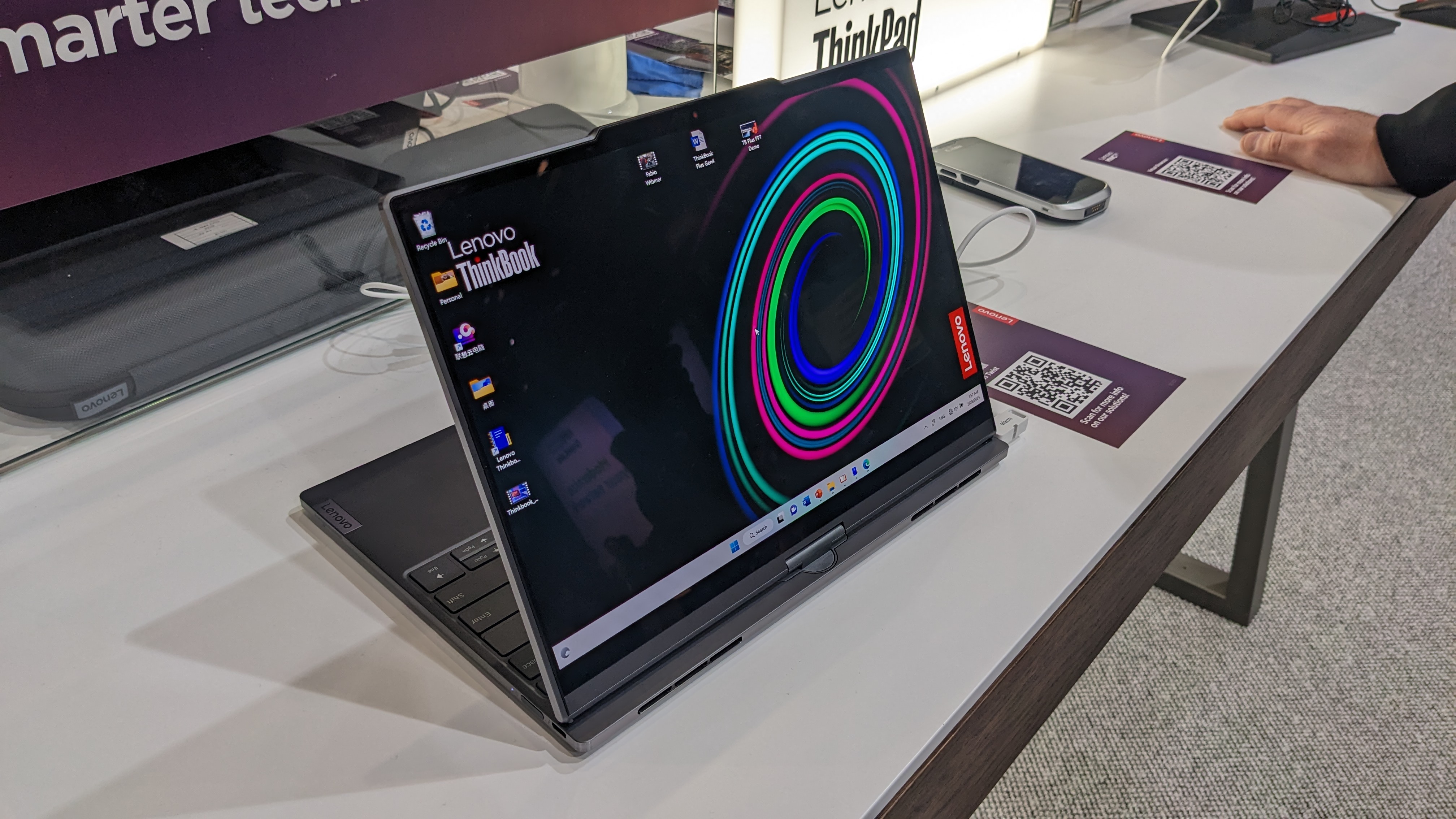
Looking at the rest of the laptop, it’s got a pleasingly thin base that keeps the overall weight low and profile slim. The keyboard doesn’t have a huge amount of key travel as a result, but the gently curved keycaps feel comfortable to use and responsive for typing. The trackpad is on the small side, but felt accurate and durable with a firm click on the bottom half.
The hinge is unusual in that it’s centrally mounted on a rotating disc. It feels robust enough (we didn’t find any wobble in it during repeated swaps between configurations) but it can only be rotated 180 degrees in one direction. A Lenovo rep explained this was to protect the wiring connecting the display, which did make us a little concerned about damage if a user accidentally tried to rotate it in the wrong direction. We also reckon that a laptop sleeve could be a necessity here, to avoid damage to the exterior display when the Twist is in your bag.
There are two 1080p webcams - one above each display, so you have a camera available regardless of configuration - and a physical camera kill switch for privacy. There’s also a fingerprint scanner, but no IR cameras, so you can’t log in using facial recognition with Windows Hello. The physical port selection is quite meager too, with just two Thunderbolt 4-enabled USB-C ports, which are also used for charging. This was a sacrifice made to retain thinness and portability, but it’s still a shame.
The FHD webcams and dual mic array with Dolby Atmos-enabled twin speakers mean that the Lenovo ThinkBook Plus Twist should also be great for video calls, making the ThinkBook Plus Twist potentially excellent for professionals on the move - especially given a unique quirk of its battery life, but we’ll get into that later.
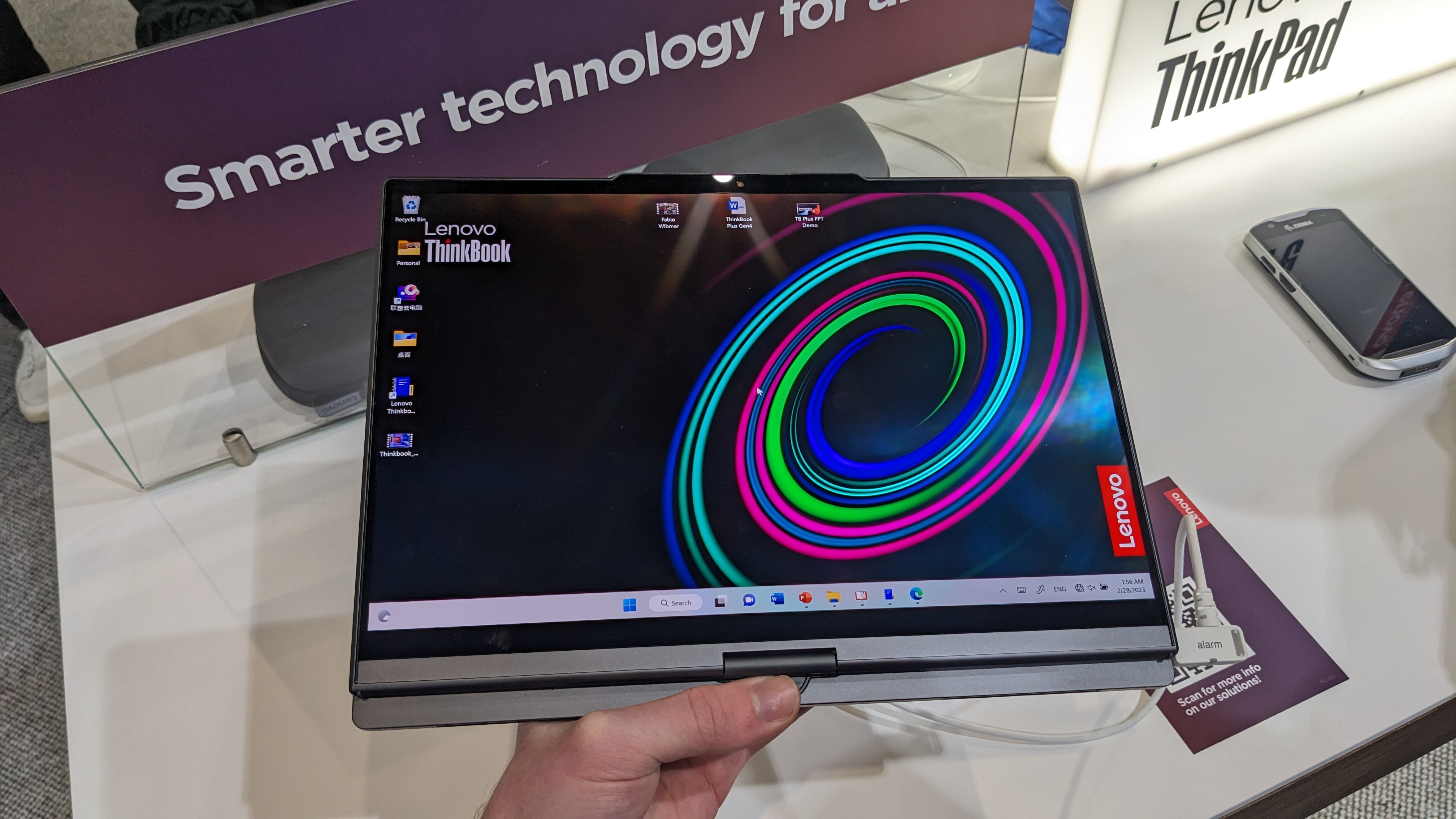
Lenovo ThinkBook Plus Twist review: Performance
While Lenovo wasn’t about to let me download and run a bunch of benchmarking software on the ThinkBook Plus Twist at MWC, I can at least extrapolate the sort of performance this laptop will be capable of.
With an Intel Core i7-1355U processor running Iris Xe integrated graphics and 16GB of LPDDR5X RAM, the model I saw at the event should be no slouch when it comes to everyday workloads. You won’t be playing the latest triple-A games on it without seriously compromising on graphical quality, but it should cope well with straightforward tasks such as word processing and web browsing and hopefully can stand up to more demanding operations like video editing or digital art.
You can get up to 1TB of storage, which Lenovo has confirmed is a PCIe 4.0 SSD, meaning you’ll have seriously speedy data transfer speeds and plenty of storage capacity. The battery is a 56Whr unit, which I imagine will give it a reasonable, but not outstanding, battery life. There’s a big caveat here, though: that assumes you’re using the regular OLED screen.
If you spin the Lenovo ThinkBook Plus Twist into ‘typewriter mode’, you can work away on your novel or poetry or (more likely) assignments while also saving your battery life. The Smart Paper display uses just a fraction of the power consumed by the OLED panel. Since E Ink screens are well-suited for use in brightly lit environments, you won’t have to turn up your display brightness either, letting you go for longer between charges when you’re on the go. This could make it one of the best laptops for writers when it launches.
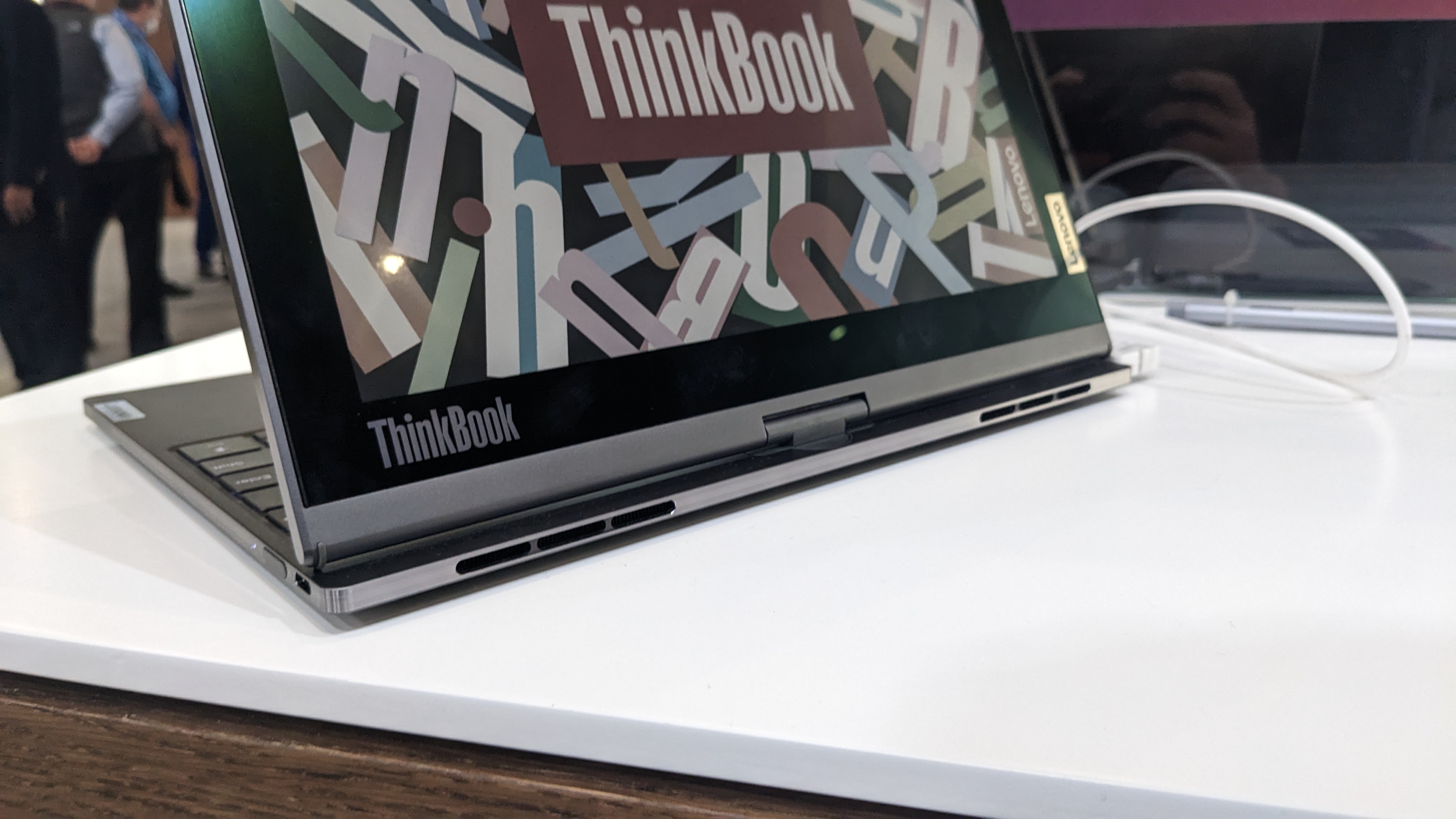
Lenovo ThinkBook Plus Twist review: Early verdict
I was genuinely impressed with the Lenovo ThinkBook Plus Twist, and it wasn’t the laptop I was expecting to be excited about at MWC. It’s an innovative revisit to a solid product past its time, combining Lenovo’s sound laptop designs with its new Smart Paper (which, by the way, is available in a standalone tablet model).
I hope that this reincarnation of the Twist finds a successful niche; it’s an unusual product but it justifies its existence with useful features and a portable, versatile design. If the 13th-gen Intel processors can pull their weight - and I bet that Lenovo is coaxing good performance from them - then the ThinkBook Plus Twist should be a worthy successor - even if it has arrived more than ten years late.
0 comments:
Post a Comment